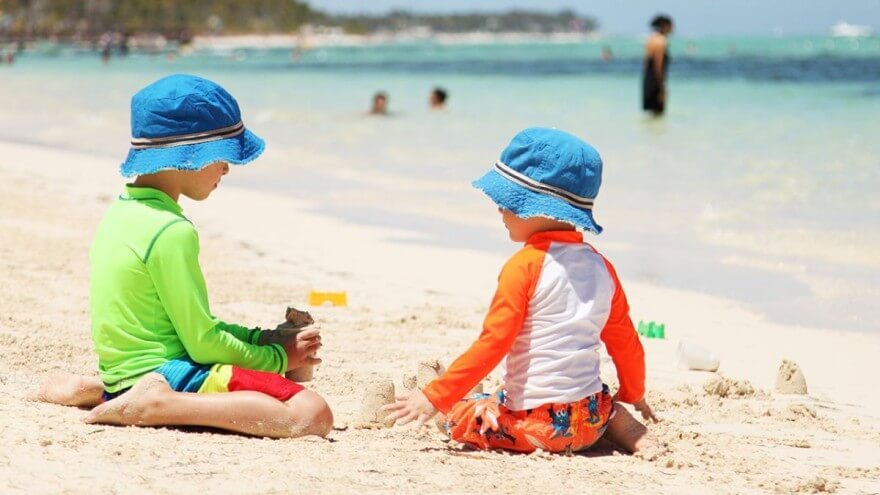As summer approaches, it’s crucial to prioritize your child’s safety and well-being during this season of fun and play. The warm weather invites various outdoor activities but also brings potential risks that parents and guardians should be aware of. Staying informed about the hazards linked to summer activities can help you prevent accidents and ensure your children enjoy their time safely.

With increased playtime outside, children are more exposed to the sun and higher temperatures, making it vital to understand the importance of hydration and proper nutrition. Additionally, protecting skin from sunburn and choosing the appropriate protective gear for activities, from bike riding to swimming, can dramatically reduce the risk of injuries. It’s also essential to have a clear plan for summer that includes what to do in case of emergencies and how to keep children supervised and safe in different environments.
Key Takeaways
- Ensuring kids stay hydrated and nourished is vital during summer.
- Proper protective wear can mitigate injury risks during outdoor activities.
- Planning and supervision are critical to a fun and safe summer for children.
Understanding Summer Risks and Safety Basics

Summer brings fun opportunities for outdoor activities but also introduces various risks, such as heat-related illnesses, water accidents, and skin damage due to prolonged sun exposure. Knowing how to mitigate these risks is essential to ensure a safe and enjoyable summer for children.
Preventing Heat-Related Illnesses
Heat-related illnesses occur when the body is unable to cool itself properly. Heat exhaustion and heat stroke are severe conditions that can be prevented.
- Stay Hydrated: Drink plenty of fluids to maintain good hydration. Encourage your child to drink water regularly, avoiding sugary drinks and caffeine.
- Rest Periods: Schedule breaks in a cool area, especially during peak sun hours.
- Wear Appropriate Clothing: Dress in lightweight, breathable clothing that allows sweat to evaporate.
Water Safety and Drowning Prevention
Drowning is a leading cause of injury-related death in children. To keep your child safe near water:
- Supervision: Always actively watch children when they are in or around water.
- Swimming Lessons: Enroll your child in swimming lessons; basic swimming skills can be lifesaving.
- Safety Gear: Use life jackets in and around natural bodies of water, no matter how well your child can swim.
Sun Protection and Skin Care
Protecting your child’s skin from the harmful effects of ultraviolet rays is vital to reduce the risk of sunburn and skin damage.
- Sunscreen Application: Apply broad-spectrum sunscreen with an SPF of at least 30. Reapply every two hours or after swimming or sweating.
- Protective Clothing: Outfit your child in sun-protective clothing, such as wide-brimmed hats and long-sleeved shirts.
- Seek Shade: Encourage playing in shaded areas, especially midday when the sun is most intense.
Nutrition and Hydration
Proper nutrition and sufficient hydration are essential for your child’s health during the summer. Emphasize various fruits, vegetables, and wholesome meals, along with a regular water intake to combat the heat.

Healthy Eating During Summer
During the warmer months, your child’s body needs fuel from healthy food choices. Opt for:
- Fruits and Vegetables: Aim for a rainbow of colors on their plate. Fruits like watermelon and berries serve as hydration and nutrient sources. Vegetables in salads or crudité are refreshing and full of fiber.
- Fiber-Rich Foods: Choose whole grains, beans, and legumes to keep their digestion regular and to promote satiety.
- Healthy Fats: Incorporate sources such as avocados, nuts, and seeds. These can be added to salads or eaten as snacks.
- ‘Whoa’ Foods: To maintain a balanced diet, limit foods high in sugar and fat, categorizing them as “sometimes” choices.
Remember, integrating healthy eating tips into your child’s summer routine does not have to be complex. Simple adaptations like swapping out ice cream for a homemade fruit popsicle can make a big difference.
Staying Hydrated in the Heat
To prevent dehydration, encourage your child to drink plenty of water, especially if they are active outdoors. Consider the following tips:
- Ensure they drink water before, during, and after physical activity.
- Set a schedule for water breaks if they are resistant to drinking water.
- Provide flavored water with slices of fruits such as lemon or cucumber to make hydration more appealing.
It’s important to note that sugary drinks should not replace water as the primary source of hydration. Educate your child on choosing water over sodas and listen to their body’s thirst signals.
Keeping Active While Staying Safe

To maintain safety during the summer, it is critical to balance indoor and outdoor activities and adhere to sports and recreation safety guidelines.
Indoor Versus Outdoor Activities
Indoor Play:
To stay active indoors, circulate a variety of activities:
- Board games
- Puzzle building
- Home-based obstacle courses
Outdoor Recreation:
When planning outdoor games, be mindful of the heat and sun exposure, and choose the more excellent hours of the day for physical activities. Consider:
- Early morning gardening
- Evening family nature club outings utilizing a toolkit for safe exploration
- Water play in a splash pad or pool with adult supervision
Sports and Recreation Safety Tips
New Sports:
When trying a new sport, ensure:
- Appropriate safety gear is worn (e.g., helmets for biking)
- Initial guided instruction for proper technique
Swimming:
For swimming and other water-related activities:
- Always have an adult present
- Use life jackets in deep water or if not a confident swimmer
Remember, summer activities should be fun and safe, focusing on recreation that suits your interests and health considerations.
Protective Wear and Injury Prevention

Choosing the proper protective wear can significantly reduce your child’s risk of injury during summer activities. From appropriate clothing to the right gear for specific activities, taking these precautions keeps your summer safe and fun.
Clothing and Accessories
- Hat: A wide-brimmed hat protects the face, neck, and ears from the sun.
- Clothing: Opt for lightweight, long-sleeved shirts and pants to shield skin from UV rays.
- Sunscreen: Apply a broad-spectrum sunscreen with at least SPF 30 every two hours after swimming or sweating.
- Sunglasses: To protect your child’s eyes, ensure they block 99-100% UVA and UVB rays.
- Shade: Encourage playing in shaded areas during peak sun hours to minimize sun exposure.
Helmets and Life Jackets
- Helmet Safety: Always have your child wear a properly fitted helmet during biking, skateboarding, or wheeled sports.
- Fit: The helmet should sit level on your child’s head and not rock side to side.
- Buckle: The chin strap should be snug but comfortable, allowing no more than one to two fingers’ space.
- Life Jacket: Mandatory for boating and recommended for swimming, especially for weak swimmers.
- Size: Ensure the life jacket fits snugly without room for your child to slip out.
- U.S. Coast Guard Approval: Only use life jackets approved by the U.S. Coast Guard for guaranteed safety.
Remember to keep children away from fireworks or ensure a responsible adult is in charge during displays to prevent injuries. Prioritize safety to make the most of your summer experiences.
Planning for a Safe Summer

As summer approaches, it’s crucial to outline a comprehensive plan incorporating a structured daily routine and preparing your family for emergencies to ensure your children’s safety and well-being.
Daily Routines and Sleep
Establish a Consistent Sleep Schedule: To combat fatigue and reduce stress, maintain a regular sleep routine for your kids. Aim for a sleep duration that aligns with the recommendations from pediatricians and the CDC, which suggest:
| Age Group | Recommended Sleep Duration |
|---|---|
| 3-5 years | 10-13 hours per 24-hour period |
| 6-12 years | 9-12 hours per 24-hour period |
| 13-18 years | 8-10 hours per 24-hour period |
Enforce Daily Sun Protection: Incorporate sun safety into your child’s routine. Before heading out, apply a broad-spectrum sunscreen with a minimum SPF of 30. Dress them in light-colored, loose-fitting clothing and wide-brimmed hats for added protection.
First Aid and Emergency Preparedness
Equip Your Home and Car with First Aid Kits: Ensure you have fully stocked kits at home and in your vehicle. Include items like bandages, antiseptics, tweezers, and allergy medication. Check the kits regularly to replenish supplies.
Emergency Contacts and Procedures: Teach your children to dial emergency services and which situations warrant a call. Keep a list of contacts, including the nearest hospital and your pediatrician, in an easily accessible place. Additionally, if your child goes to a summer camp, confirm the camp’s emergency plans and understand their communication protocols.
Following these specific planning steps, you’ll be well-equipped to provide your kids with a safe, healthy, and fun summer.
Frequently Asked Questions
Ensuring your child’s safety during summer is paramount. The following subsections answer common questions to help parents and caregivers protect children from summer hazards.
How can parents ensure their children’s safety during school summer activities?
You can ensure safety during school summer activities by staying informed of the school’s safety policies, ensuring your child understands the importance of hydration and sunscreen, and staying within designated areas. Communicate any concerns directly with the people in charge.
What are the essential summer safety tips for children playing outside?
Ensure children wear appropriate clothing, including a hat and sunglasses. Always apply broad-spectrum sunscreen SPF 30 or higher and teach children to seek shade regularly. Supervision is crucial, and establishing check-in times can prevent accidents and overheating.
What measures should be taken to protect kids from heat-related illnesses in summer?
Children should be encouraged to drink water regularly, even when thirsty. To avoid heat exhaustion, schedule outdoor activities during more excellent parts of the day and make sure they rest in cool, shaded areas. Recognize signs of heat-related illnesses, such as dizziness and nausea.
How can caregivers provide a safe home environment for kids during the summer months?
Child-proof your home by securing windows, setting rules about playing near water sources like pools, and storing chemicals out of reach. Ensure your home is cool enough to prevent overheating and equip kids with indoor activities during extreme heat.
What guidelines do the CDC recommend for children’s summer safety?
The CDC recommends that children wear sun protection gear, avoid high-intensity activities during peak sun hours, stay hydrated, and use insect repellent when necessary. Properly managing allergies and asthma is also advised, as triggers could differ during summer.
What are the best ways to educate elementary students about summer safety?
Interactive activities such as safety-themed coloring books, role-playing, and watching educational videos can effectively teach children about summer safety. Reinforce this information with quizzes and discussions to ensure understanding and retention of essential safety practices.